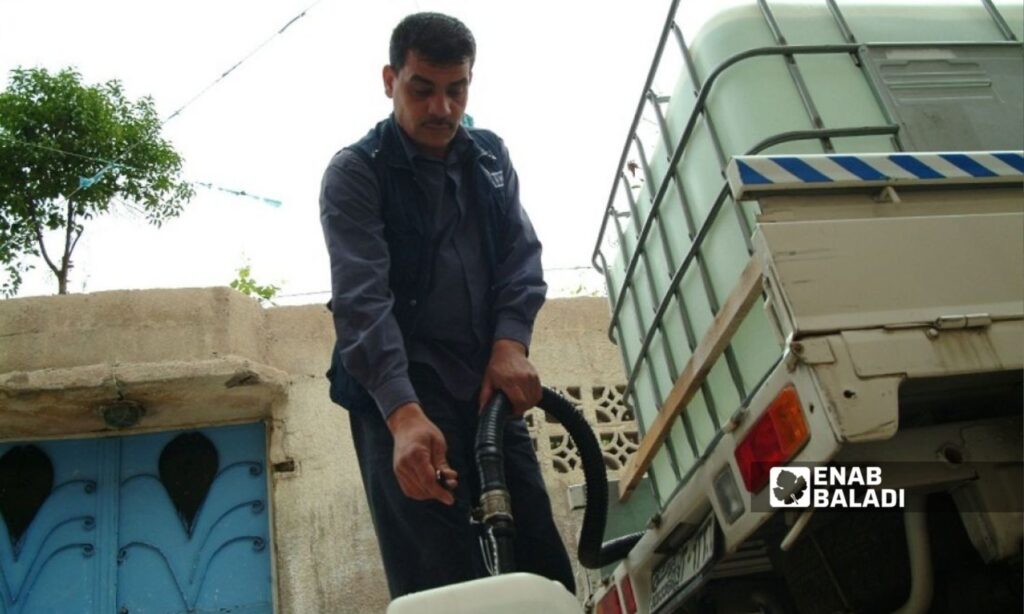“The cheapest item when available and the most expensive when missing,” a saying about water that we have become accustomed to hearing, but in reality, the scene is different. Water has become the most expensive resource, both available and lost, in the suffering experienced by some families in rural Damascus.
The suffering of the residents of Sahnaya due to insufficient water supply to some neighborhoods during pumping has been ongoing for years.
Due to water being supplied only two days a week during power outages, residents rely on generators or the installation of solar panels, or they fill up unpotable water from water tanks. In all cases, these represent expensive solutions that an average employee cannot bear.
Wafa, a resident of Sahnaya living on al-Nujoom Street, told Enab Baladi that she has suffered over the years from a lack of water in her residential neighborhood, despite continuous demands from residents to improve the water supply to their area.
Water is often pumped once a week during power outages, which poses a challenge for it to reach the tank located on the building’s roof. As she lives on the third floor, the water does not reach the tank, which has pushed her to rely almost entirely on filling water from the tanks, which has added a burden to their monthly expenses as a family.
Wafa added that filling a tank of 5 barrels once a week costs between 35,000 and 40,000 Syrian pounds.
Meanwhile, the price for filling a tank of 10 barrels has reached 70,000 Syrian pounds.
A water filling tank in the al-Tanzeem neighborhood in Sahnaya, rural Damascus (Enab Baladi/Social Media)
Shortage and urban expansion
Engineer Munib Dahar, head of the water unit in Sahnaya, told Enab Baladi that the area of Sahnaya and Ashrafiyat Sahnaya relies primarily on the Damascus station.
The water supply line coming from the Fijah spring suffered a malfunction about two weeks ago, resulting in water cuts for Sahnaya and some areas of Damascus.
He clarified that the reasons for the lack of water are related to Sahnaya’s almost total dependence on external supply sources, and the wells located in the farms around Sahnaya cover less than 5 percent of residents’ needs, especially with the decline in water levels as this winter has been almost dry.
In addition, the urban expansion that Sahnaya has witnessed, with about 900,000 building permits issued in the last four years, has created a gap in water service provision for these new buildings, as there hasn’t been a corresponding expansion in water supply lines.
Stalled projects
Despite water being pumped twice a week to Sahnaya, residents do not benefit from water filling during power outages. When electricity is available for just one hour due to rationing, it is insufficient for water to reach all neighborhoods of Sahnaya.
This has led residents to rely on the tanks that obtain water from a station located in a small village near Sahnaya.
These tanks contain about three wells, supplying the tanks with water, and they are licensed, according to what Munib Dahar, head of the water unit in Sahnaya, reported.
Dahar hopes to resume work on a project initiated by the Roads and Water Projects Company in October 2024, known among residents as the “Main Reservoir Project” or “Al-Mastabah Reservoir.”
The reservoir has a capacity of 10,000 cubic meters and is among the largest projects in rural Damascus, serving four main residential areas: Sahnaya, Ashrafiyat Sahnaya, the 8th of March suburb, and al-Kiswah.
This will alleviate the residents’ problems by supplying water regularly without relying on pumps that depend on electricity.
So far, 40 percent of the project has been completed, which was halted after the regime’s fall, pending approval from the transitional government to resume work, according to Munib Dahar.
Repeated struggles in Jaramana
The situation is not much different in Jaramana, where the water crisis is also a burden for residents, especially under the current difficult economic conditions. Filling one tank of 5 barrels through tanks costs between 60,000 to 80,000 Syrian pounds.
Some residents of Jaramana spoke to Enab Baladi about their struggles in securing water, as they need both potable water and water for domestic use, leading them to buy it from street vendors in the city.
They noted that this crisis is not new and recurs from time to time, with reduced electricity hours exacerbating the problem.
The director of the Jaramana water unit, Saeed Halabi, explained to Enab Baladi that the root of the water crisis in the city is the lack of sufficient electricity supply for residents to fill their water tanks.
The city receives three hours of electrical supply per day, which is insufficient for all residents, and it is known that Jaramana suffers from overcrowding.
Halabi added that those with solar panels or private generator subscriptions can easily fill water; the pumping does not stop. However, during the one hour of supply that comes to the entire city at the same time, not everyone can fill their tanks.
He noted that the line exempt from rationing connected to water wells in the city has not been canceled, and there are no issues with the wells or pumps.
To alleviate the burden on residents, a water rationing program has recently been implemented for the neighborhoods of the city, where some neighborhoods are supplied one day and then cut the next day to redirect water to other neighborhoods, according to a schedule that has been set.
This means that there is now a schedule for water supply (one day on, one day off), considered a temporary phase until the hours of electricity supply to the city can be increased, according to Halabi.
In general, rural Damascus faces a scarcity of water resources due to insufficient rainfall this year.

